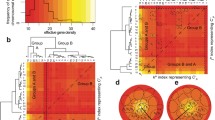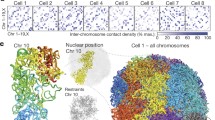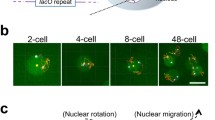Abstract
Specific chromosome domains in interphase nuclei of neurons and glia were studied by three-dimensional (3-D) reconstruction of serial optical sections from in situ hybridized human CNS tissue. Overall patterns of centromere organization, delineated with alphoid repeats, were comparable to those seen in mouse, and are clearly conserved in mammalian evolution. Cloned probes from other individual chromosome domains were used to define interphase organization more precisely. Homologous chromosomes were spatially separated in nuclei. In large neurons, probes specific for 9q12, or 1q12 showed that at least one homolog was always compartmentalized together with centromeres on the nucleolus, while the second signal either abutted the nucleolus or was on the nuclear membrane. A telomeric Yq12 sequence also localized together with perinucleolar centromeres in a completely non-Rabl orientation. In astrocytes, these three chromosome regions were on the membrane and not necessarily associated with nucleoli. Therefore there are different patterns of interphase chromosome organization in functionally distinct cell types. In contrast to the above domains, a 1p36.3 telomeric sequence embedded in a large Alu-rich and early replicating chromosome region, was always found in an interior euchromatic nuclear compartment in both neurons and glial cells. In double hybridizations with 1q12 and 1p36.3 probes, 1p arms were clearly separated in all cells, and arms projected radially into the interior nucleoplasm with non-Rabl orientations. There was no absolute or rigid position for each 1p arm with respect to each other or to the major dendrite, indicating that individual chromosome arms may be dynamically positioned even in highly differentiated cell types. We suggest that centromeric and other highly repeated non-transcribed sequence domains may act as general organizing centers for cell type specific interphase patterns that are conserved in mammalian evolution. Such centers would allow selected groups of chromosome arms to extend into (and contract from) an interior, presumably transcriptionally active, nuclear compartment.
Similar content being viewed by others
References
Ashley T (1979) Specific end to end attachment of chomosomes in Ornithogalum virens. J Cell Sci 39:357–367
Avivi L, Feldman M (1980) Arrangement of chromosomes in the interphase nucleus of plants. Hum Genet 55:281–295
Bennett MD (1982) Nucleotypic basis of the spatial ordering of chromosomes in eukaryotes and the implications of the order for genome evolution and phenotypic variation. In: Dover GA, Flavell RB (eds) Genome evolution. Academic Press, London New York, pp 239–260
Blobel G (1985) Gene gating: a hypothesis. Proc Natl Acad Sci USA 82:8527–8529
Boveri T (1909) Die Blastomerenkerne von Ascaris megalocephala und die Theorie der Chromosomenindividualität. Arch Exp Zellforsch 3:181–268
Boyde A (1985) Stereoscopic images in confocal (tandem scanning) microscopy. Science 230:1270–1272
Brakenhoff GJ, van der Voort HTM, van Sprousen EA, Linnemans WA, Nanningan N (1985) Three dimensional chromatin distribution in neuroblastoma nuclei shown by confocal scanning microscopy. Nature 317:748–749
Bridges CB (1935) Salivary chromosome maps. J Hered 26:60–64
Buroker NE, Bestwick R, Haight G, Magenis RE, Litt M (1987) A hypervariable repeated sequence on human chromosome 1p36. Am J Hum Genet 77:175–181
Capco DG, Krochmalnic G, Penman S (1984) A new method of preparing embeddment-free sections for transmission electronmicroscopy: applications to the cytoskeletal framework and other three-dimensional networks. J Cell Biol 98:1878–1885
Cooke HJ, Hindley J (1979) Cloning of human satellite III DNA: different components are on different chromosomes. Nuclei Acids Res 6:3177–3197
Cooke HJ, Schmidtke J, Gosden JR (1982) Characteristics of a human Y chromosome sequence and related sequences in higher primates. Chromosoma 87:491–502
Cremer T, Tesin D, Hopman AHN, Manuelidis L (1988) Rapid interphase and metaphase assessment of specific chromosomal changes in neuroectodermal tumor cells by in situ hybridization with chemically modified DNA probes. Exp Cell Res, in press
De Buoni U, Mintz AH (1986) Curvilinear, three-dimensional motion of chromatin domains and nucleoli in neuronal interphase nuclei. Science 234:863–866
Earnshaw WC, Sullivan KF, Machlin PS, Cooke CA, Kaiser DA, Pollard TD, Rothfield NF, Cleveland DW (1987) Molecular cloning of CDNA for CENP-B, the major human centromere autoantigen. J Cell Biol 104:817–829
Ellison JR, Howard GC (1981) Non-random position of the A-T rich DNA sequences in early embryos of Drosophila virilis. Chromosoma 83:555–561
Gendelman HE, Moench TR, Narayan O, Griffin DE, Clements JE (1985) A double labeling technique for performing immunocytochemistry and in situ hybridization in virus infected cell and tissue. J Virol Methods 11:93–103
Goldman MA, Holmquist GP, Grey MC, Caston LA, Nag A (1984) Replication timing of mammalian genes and middle repetitive sequences. Science 224:686–692
Hadlaczky G, Went M, Ringertz NR (1986) Direct evidence for the non-random localization of mammalian chromosomes in the interphase nucleus. Exp Cell Res 167:1–15
Hochstrasser M, Sedat J (1987a) Three-dimensional organization of Drosophila melanogaster interphase nuclei. I. Tissue-specific aspects of polytene nuclear architecture. J Cell Biol 104:1455–1470
Hochstrasser M, Sedat JW (1987b) Three-dimensional organization of Drosophila melanogaster interphase nuclei. II. Chromosomal spatial organization and gene regulation. J Cell Biol 104:1455–1470
Holmquist G (1988) DNA sequences in G bands and R bands, vol II. Adolph KW (ed) CRC Press, Bocca Raton, in press
Hopman AH, Wiegant J, Rapp AK, Landegent JE, Van der Ploeg M, Van Duijn P (1986) Bi-color detection of two target DNAs by non-radioactive in-situ hybridization. Histochemistry 85:1–4
Hutchison N, Weintraub H (1985) Localization of DNAse I-sensitive sequences to specific regions of interphase nuclei. Cell 43:471–482
Inoué S (1986) Video microscopy. Plenum Press, New York
Lawrence JB, Villnave CA, Singer RH (1988) Interphase chromatin and chromosome gene mapping by fluorescence detection of in situ hybridization reveals the presence and orientation of two closely integrated copies of EBV in a human lymphoblastoid cell line. Cell 52:51–61
Lischwe MA, Richards RL, Busch RK, Busch H (1981) Localization of phosphoprotein C23 to nucleolar structures and to the nucleolus organizer regions. Exp Cell Res 136:101–109
Manuelidis L (1978) Chromosomal localization of complex and simple repeated DNAs. Chromosoma 66:23–32
Manuelidis L (1982a) Nucleotide sequence definition of a major human DNA, the Hind III, 1.9 kb repeat segment. Nucleic Acids Res 10:3211–3219
Manuelidis L (1982b) Repeated DNA sequences and nuclear structure. In: Dover GA, Flavell RB (eds) Genome evolution. Academic Press, London New York, pp 263–285
Manuelidis L (1984a) Different CNS cell types display distinct and non-random arrangements of satellite DNA sequences. Proc Natl Sci USA 181:3123–3127
Manuelidis L (1984b) Active nucleolus organizers are precisely positioned in adult central nervous system cells but not in neuroectodermal tumor cells. J Neuropathol Exp Neurol 43:225–241
Manuelidis L (1985a) Indications of centromere movement during interphase and differentiation. Ann NY Acad Sci 450:205–221
Manuelidis L (1985b) Individual interphase chromosome domains revealed by in situ hybridization. Hum Genet 71:288–293
Manuelidis L (1985c) In situ detection of DNA sequences using biotinylated probes. Focus 7:4–8
Manuelidis L, Ward DC (1984) Chromosomal and nuclear distribution of the Hind III 1.9 kb repeat segment. Chromosoma 91:28–38
Mathog D, Hochstrasser M, Gruenbaum Y, Saumweber H, Sedat J (1984) Characteristic folding pattern of polytene chromosomes in Drosophila salivary gland nuclei. Nature 308:414–421
Moroi Y, Hartman AL, Nakane PK, Tan EM (1981) Distribution of kinetochore (centromere) antigen in mammalian cell nuclei. J Cell Biol 90:254–259
Moyzis RK, Albright KL, Bartholdi MF, et al. (1987) Human chromosome-specific repetitive DNA sequences: novel markers for genetic analysis. Chromosoma 95:375–386
Pinkel D, Gray JW, Trask B, van den Engh G, Fuscoe J, van Dekken H (1986) Cytogenetic analysis by in-situ hybridization with fluorescently labeled nucleic acid probes. Cold Spring Harbor Symp Quant Biol 51:151–157
Pomerat CM, Hendelman WJ, Raiborn CW, Massay JF (1967) Dynamic activities of nervous tissue in vitro. In: Hydén H (ed) The neuron. Elsevier, Amsterdam, pp 119–178
Rabl C (1885) Über Zellteilung. Morphol Jahrb 10:214–330
Radic MZ, Lundgren K, Hamkalo BA (1987) Curvature of mouse satellite DNA and condensation of heterochromatin. Cell 50:1101–1108
Rappold GA, Cremer T, Hager HD, Davies KE, Müller CR, Yang T (1984) Sex chromosome positions in human interphase nuclei as studied by in situ hybridization with chromosome specific DNA probes. Hum Genet 67:317–325
Ringertz N, Hadlaczky G, Hallman H, Nyman U, Petterson I, Sharp GC (1986) Computer analysis of the distribution of nuclear antigens: studies on the spatial and on the functional organization of the interphase nucleus. J Cell Sci Suppl 4:11–28
Schardin M, Cremer T, Hager HD, Lang M (1985) Specific staining of human chromosomes in Chinese hamster x man hybrid cell lines demonstrates interphase chromosome territories. Hum Genet 71:281–287
Scheer U, Rose KM (1984) Localization of RNA polymerase I in interphase cells and mitotic chromosomes by light and electron microscopic immunocytochemistry. Proc Natl Acad Sci USA 81:1431–1435
Sedat J, Manuelidis L (1978) A direct approach to the structure of eukaroytic chromosomes. Cold Spring Harbor Symp Quant Biol 42:331–350
Sperling K, Lüdtke EK (1981) Arrangement of prematurely condensed chromosomes in cultured cells and lymphocytes of the Indian Muntjac. Chromosoma 83:541–553
Stewart C, Burke B (1987) Teratocarcinoma stem cells and early mouse embryos contain only a single major lamin polypeptide closely resembling lamin B. Cell 51:383–392
Vogel W, Autenrieth M, Speit G (1986) Detection of bromodeoxyuridine-incorporation in mammalian chromsomes by a bromodeoxyuridine antibody. Hum Genet 72:129–132
White JG, Amos WB, Fordham W (1987) An evaluation of confocal versus conventional imaging of biological structures by fluorescence light microscopy. J Cell Biol 105:41–48
Willard H (1985) Chromosome-specific organization of human alpha satellite DNA. Am J Hum Genet 37:524–532
Wu JC, Manuelidis L (1980) Sequence and organization of a human repeated DNA. J Mol Biol 142:363–386
Yang TP, Hansen SK, Osiki KK, Ryder OA, Hamkalo BA (1982) Characterization of a cloned repetitive DNA sequence concentrated on the human X chromosome. Proc Natl Acad Sci USA 79:6593–6597
Zhai Z, Nickerson JA, Krochmalnic G, Penman S (1987) Alterations in nuclear matrix structure after adenovirus infection. J Virol 61:1007–1018
Author information
Authors and Affiliations
Rights and permissions
About this article
Cite this article
Manuelidis, L., Borden, J. Reproducible compartmentalization of individual chromosome domains in human CNS cells revealed by in situ hybridization and three-dimensional reconstruction. Chromosoma 96, 397–410 (1988). https://doi.org/10.1007/BF00303033
Received:
Revised:
Issue Date:
DOI: https://doi.org/10.1007/BF00303033




